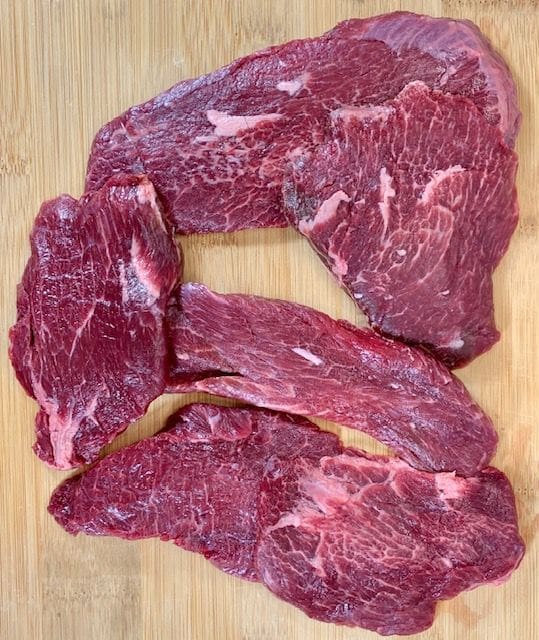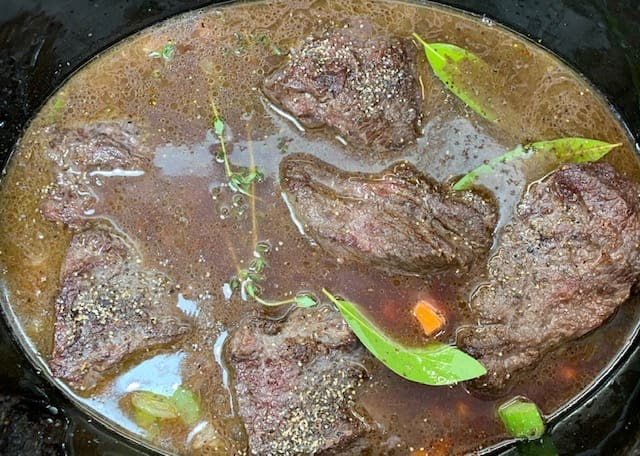
Beef cheeks are precisely what their name suggests—the cheek muscles of a cow. These muscles are incredibly tough, and for good reason. If you stop to consider how much a cow uses its cheeks, it makes perfect sense, constantly grazing and chewing from dawn to dusk.
Because of their natural toughness, beef cheeks require slow, gentle cooking to unlock their potential. When prepared correctly, they transform into a succulent, tender cut bursting with rich flavor. This makes them a favorite among chefs and foodies who appreciate the art of turning humble, overlooked cuts into delicious bites.
Beef cheeks are featured in the aptly named event, An Offal Good Dinner. Celebrating the underrated and underutilized parts of the animal, this dinner showcases the unique textures and deep flavors that cuts like beef cheeks bring to the table, making it a celebration of nose-to-tail cooking.
Prepping Beef Cheeks
Let me tell you about my first experience with beef cheeks. When I asked my butcher for them, he admitted no one had ever made such a request before—and it showed. He handed them over with the outer membrane still intact, something I quickly discovered was no small challenge to deal with. That membrane was tougher than shoe leather and clung to the meat like it was fused with industrial epoxy. Removing it was a painstaking process that took forever, and only a razor-sharp knife—sharp enough to shave with—could get the job done.
Lesson learned. The next time I ordered beef cheeks, I made sure to ask the butcher to prep them properly. He chuckled and said, “You do know there are three membranes in a cheek, right?” I didn’t, but I was relieved when I unwrapped the second batch to find them perfectly cleaned and ready to go. That little extra request saved me hours of labor and made the cooking process so much smoother!

Making Braised Beef Cheeks
Season the beef and sear them in olive oil, followed by sauteeing the vegetables. Transfer the vegetables to the slow cooker, then place the beef on top like the image below.


Deglaze the pan with wine, scraping to recover all those tasty brown bits, then pour it all into the slow cooker with the beef stock, bouquet garni and bay leaves. Cover and cook for 6-7 hours on low heat.

Remove the beef cheeks from the braising liquid and veggies, set aside and keep warm. Remove the bouquet garni and bay leaves, then use an immersion blender to create a delicious gravy. Taste and adjust salt and pepper to taste.
Return the cheeks to the gravy to keep warm until ready to serve. Print
Beef Cheeks
Braised beef cheeks with onion, celery, carrot in a red wine reduction
- Prep Time: 30
- Cook Time: 420
- Total Time: 7 hours 30 minutes
- Yield: 4-6 servings 1x
Ingredients
- 4 TBL olive oil – divided
- 3 lbs beef cheeks
- 1 medium yellow onion – roughly diced
- 1 celery stalk – roughly diced
- 4 garlic cloves – minced
- 1 carrot – roughly diced
- 1 cup beef stock
- 2 cups red wine
- 2 tsp salt
- 6 stems fresh thyme
- 3 bay leaves
- Salt and black pepper to taste
Instructions
- Prep the beef cheeks by removing any fatty membrane – if necessary
- Pat them dry and season well with salt and pepper, then sear the cheeks on high heat in 3 tablespoons olive oil until both sides are nicely browned. Remove the cheeks and set aside
- Turn down the heat to medium and add the remaining olive oil.
- Saute the onion and carrot for about 3 minutes until the onions are beginning to become translucent, then add the celery and garlic and saute for 3 more minutes
- Pour the onion mixture into the slow cooker on low and place the cheeks on top
- Pour the wine into your braising pan, return to high heat, bring to a simmer, then deglaze the pan, scraping the browned bits off the bottom and mixing with the wine
- Add the wine and the beef stock to the slow cooker, tuck the herbs around the cheeks and sprinkle with salt and pepper
- Cover and cook for 6-7 hours on low
- Remove the cheeks and discard the thyme and bay leaves, blend the liquids with an immersion blender, taste and adjust seasoning.
- Cook on high until it thickens if necessary
- Lower or turn off heat and return the cheeks to the gravy to keep warm until ready to serve
